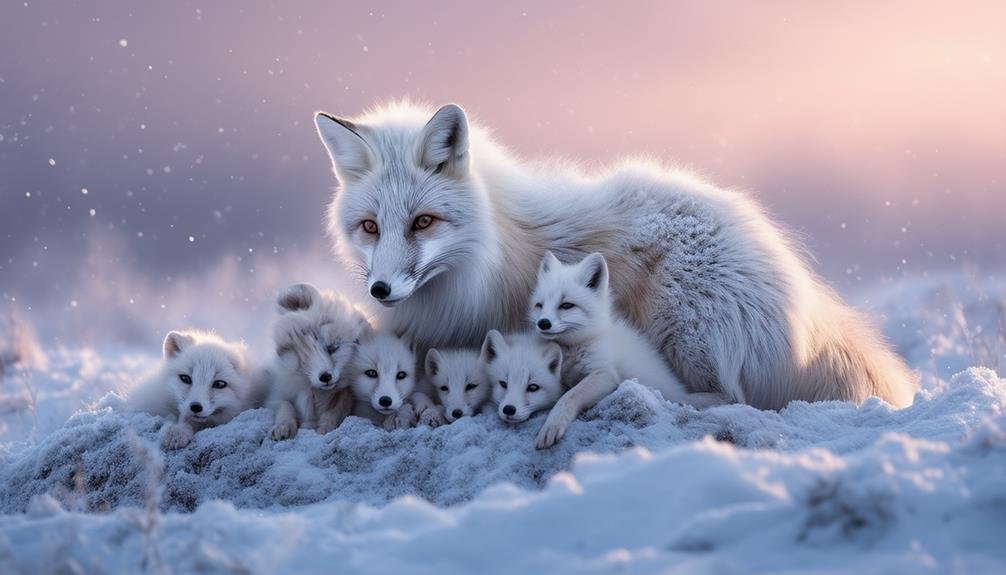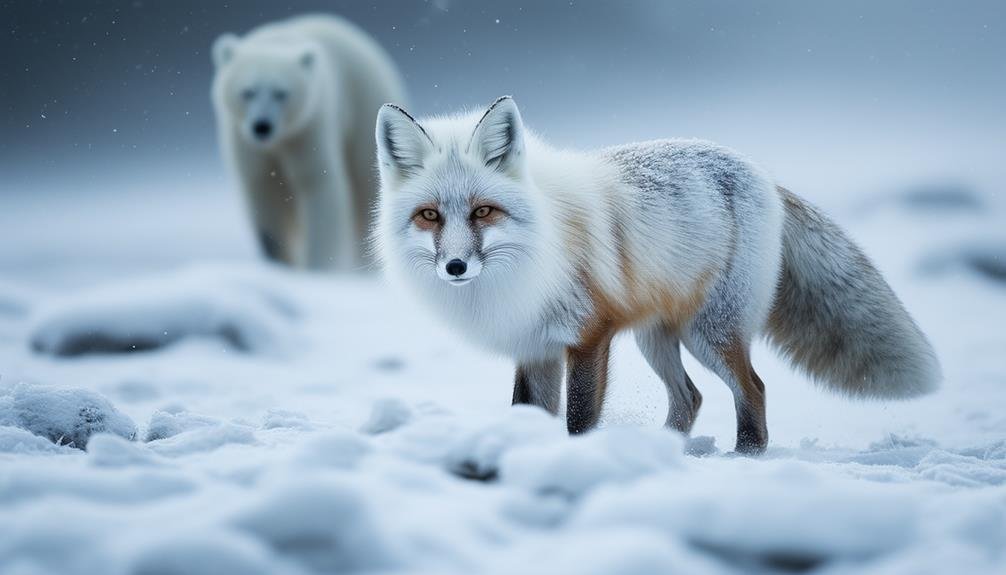Arctic foxes brave harsh winter conditions through a combination of physical and behavioral adaptations. They have thick fur and a dense undercoat, which provide excellent insulation. Their paws are covered in fur to prevent frostbite, and their small, rounded bodies minimize heat loss. They utilize subnivean spaces—areas beneath the snow—for shelter from the elements. To conserve energy, they reduce their metabolic rate by up to 25% during lean times. These foxes also store food and adjust their hunting strategies to the season. Discover more about their remarkable survival tactics and the challenges they face.
Main Points
- Arctic foxes have thick fur and an undercoat for excellent insulation against the cold.
- They use dens and subnivean spaces for protection and heat conservation.
- Their metabolic rate decreases by 25% to conserve energy during winter.
- They employ a countercurrent heat exchange system in their legs to regulate temperature.
- Their body shape is small and rounded to minimize heat loss and conserve warmth.
Winter Adaptations
In winter, Arctic foxes exhibit several remarkable adaptations that enable them to survive and thrive in extreme cold. These adaptations are essential for their survival in the harsh environments of the Arctic. One of the most notable is their thick winter coat, which becomes up to 140% denser than their summer coat, providing crucial insulation against the biting cold. This thick fur extends to their foot pads, which are covered to prevent frostbite and provide additional warmth, making it easier for them to navigate the snow-covered terrain.
Arctic foxes prefer to stay beneath the snow during winter, as these subnivean spaces offer some protection from the extreme cold and wind. Additionally, they exhibit seasonal color changes; their coat turns white in winter, offering effective camouflage against the snowy landscape, and a blue phase for better year-round insulation against the cold.
Energy storage is another vital adaptation. During the winter months, Arctic foxes slow their metabolism by about 25%, which helps conserve energy and maintain body temperature in frigid conditions. These combined adaptations highlight the Arctic fox's remarkable ability to endure and flourish in one of the planet's most extreme environments.
Survival Strategies
Building upon their remarkable winter adaptations, Arctic foxes employ a range of survival strategies to withstand the unforgiving Arctic winters. These strategies are vital for coping with harsh winter conditions, guaranteeing their survival in one of the planet's most extreme environments.
- Insulation and Fat Reserves: Prior to the onset of winter, Arctic foxes increase their body weight by over 50%, accumulating fat reserves that provide both insulation and energy. Their dense fur, which thickens during the winter months, offers exceptional insulation against extreme cold temperatures.
- Dens and Heat Conservation: Arctic foxes utilize dens to shield themselves from the brutal cold. When resting, they curl up tightly to minimize heat loss. This behavior, combined with the natural insulation properties of their fur and fat reserves, allows them to maintain a stable body temperature in their dens.
- Body Temperature Regulation: A unique adaptation in Arctic foxes is the countercurrent heat exchange system in their legs, which helps regulate body temperature. This mechanism guarantees that blood flowing to their extremities is pre-warmed, reducing heat loss and allowing them to navigate the icy terrain without succumbing to frostbite.
These survival strategies are essential for Arctic foxes, enabling them to thrive despite the extreme cold temperatures and harsh winter conditions of the Arctic environment.
Reproduction and Care

Arctic foxes typically breed in April and May, with a gestation period of about 52 days, ensuring that pups are born during the more temperate summer months. This timing optimizes the chances of survival for the offspring, as the warmer months provide better food availability and milder conditions.
Reproduction in Arctic foxes is closely tied to the abundance of food in their habitat. The number of pups born can vary significantly, with larger litters occurring when resources are ample. Both parents play an active role in the care of their offspring, working together to provide food and protection. The family unit resides in extensive dens that feature multiple entrances, offering a safeguard against predators and the harsh winter conditions.
Despite these precautions, the survival rate of Arctic fox pups is often low, highlighting the challenges these animals face. High mortality rates among the young are a stark reminder of the difficulties inherent in their environment. Nonetheless, the robust reproductive strategies and cooperative parental care employed by Arctic foxes underscore their resilience and adaptability in the face of the Arctic's extreme conditions. This intricate balance of reproduction and care is essential for their continued survival.
Diet and Hunting
Utilizing their sharp sense of smell and hearing, Arctic foxes adeptly hunt small animals like lemmings and voles to sustain themselves during the harsh winter months. These foxes are remarkably equipped to locate prey, even beneath layers of snow. Their acute hearing allows them to detect the movement of lemmings, while their sharp sense of smell can pinpoint carrion up to 40 kilometers away.
When primary prey is scarce, Arctic foxes exhibit extraordinary adaptability by scavenging. They consume carrion, bird eggs, and berries, ensuring their survival in the challenging Arctic environment. This scavenging behavior is vital during periods when hunting small animals becomes particularly challenging due to severe weather conditions.
Arctic foxes' diet and hunting strategies can be summarized as follows:
- Primary Prey: They primarily hunt lemmings and voles, demonstrating their proficiency in catching these elusive small animals.
- Scavenging: When prey is not readily available, they scavenge for carrion, bird eggs, and berries, showcasing their flexibility in food sources.
- Adaptive Hunting Techniques: Utilizing their sharp sense of smell and hearing, they can detect and capture prey even under the snow, maintaining their survival during harsh winter conditions.
This multifaceted approach to hunting and scavenging underscores the Arctic foxes' resilience and adaptability in one of the world's most extreme environments.
Predators and Threats

Facing a multitude of natural and anthropogenic threats, Arctic foxes contend with predators such as golden eagles, Arctic wolves, polar bears, wolverines, red foxes, and grizzly bears. These predators pose significant risks, particularly during the harsh winter months when food resources are scarce. Golden eagles and Arctic wolves are especially notable threats, capable of hunting Arctic foxes even in the most challenging conditions.
Climate change exacerbates these threats, contributing to the decline in Arctic fox populations. Warmer temperatures have allowed red foxes to expand their range into the Arctic, where they outcompete Arctic foxes for food and territory. This increased competition has led to a significant decline in Arctic fox numbers in some regions. For example, the Medny Island population has decreased by an alarming 85-90%.
Beyond natural predators, Arctic foxes also face anthropogenic threats, including hunting, disease, and chemical contamination. These factors further stress populations already struggling with environmental changes. To address this decline, various conservation programs have been initiated, focusing on habitat protection and mitigating the impacts of climate change. However, the challenges remain substantial, requiring continued effort and attention to guarantee the survival of these resilient creatures.
What Are the Key Adaptations Arctic Foxes Use to Survive Harsh Winter Conditions?
Arctic foxes have several key adaptations to endure extreme cold, including dense fur, a rounded body to conserve heat, and the ability to lower their metabolic rate. Their thick tail acts as insulation. These traits, combined with their keen hunting skills, enable arctic fox winter survival in some of the planet’s harshest conditions.
Conservation Efforts
Conservation efforts aimed at protecting Arctic fox populations have been implemented in several countries, including Sweden, Norway, and Finland. These initiatives are important in addressing the various challenges that these resilient creatures face, particularly in the harsh winters of the Arctic tundra.
- Protection from Hunting: In regions where Arctic fox populations are lower, hunting continues to pose a significant threat. Stricter regulations and enforcement have been introduced to mitigate this issue and help stabilize declining populations.
- Establishment of Rescue Centers: Rescue centers play a significant role in the conservation of Arctic foxes. These facilities provide care for orphaned kits, ensuring their survival and eventual reintroduction into the wild. This approach helps bolster the overall Arctic fox population and mitigates the impacts of harsh winters.
- Research and Monitoring: Ongoing research and monitoring are essential to understanding the dynamics of Arctic fox populations. Conservation efforts are continuously refined based on data regarding population trends, habitat conditions, and threats.
These measures collectively contribute to the protection of Arctic foxes, ensuring that they continue to thrive in their natural habitat despite the challenges posed by their environment.
Conclusion
Arctic foxes exhibit remarkable adaptations to withstand harsh winter conditions, including specialized fur and metabolic adjustments. Their survival strategies encompass efficient hunting techniques and the ability to store fat. Reproductive behaviors secure the care and protection of offspring during extreme weather. Despite facing natural predators and human-induced threats, ongoing conservation efforts aim to preserve their populations. These combined factors demonstrate the resilience and adaptability of Arctic foxes in one of the planet's most challenging environments.


